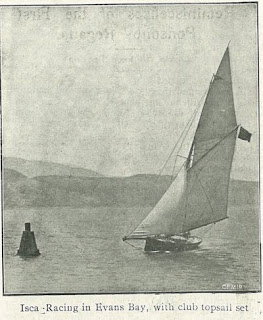 |
| Isca's lines. Probably taken off the hull. Found in Jack Maddever's shed at Clyde Quay, and now in the posession of Bruce Askew. |
Scott tweaked her up, importing a new douglas fir mast from Australia, adding a lead shoe to the counter to bring her nose up a bit, and added 3 1/2 tons of external ballast. Her performance improved somewhat, and she won a few races in Wellington, though against inferior boats - mostly converted boats never built for speed in the fist place, or racing boats imported and too light to excel in Wellington conditions. He took her to Lyttelton in 1884 to compete the anniversary regatta there, but was defeated. The Isca was taken over by E. C. Batkin, who again took her south to compete the 1886 regatta where she emerged victorious in a strong Easterly. If nothing else, she covered a lot of sea miles in her time.
 |
| Source: NZ Yachtsman 27 November 1915 |
She was a yacht of the old gentlemanly school, immaculately kept during her time in Wellington, and campaigned hard. She was a well-known and popular vessel, as were her owners and skippers, but she was never the racer many claimed her to be. However, she had the reputation of being quick in stays, and her skippers used this to advantage when working the tricky shifts on the Hutt coast off Ngauranga and Kiawharawhara. Her victories against other first division boats were generally on time allowance, and she even had trouble beating the better quality second class yachts across the line.
Isca did however, have one moment of undeniable racing glory, which unfortunately also ended in her destruction.
 |
| Source: NZ Yachtsman 02 Sept. 1916 |
The Rona was a 5-rater, desgned by G. L. Watson. The design had already proved herself in the shape of Valentine. Rona was part of the new breed of yacht - firmer bilges, more beam, less forefoot, long shallow keel - which lead to less wetted surface area and more boyancy. Rona by today's standards may have slack bilges and a large wetted surface area, but boats like her were light in comparison with the "Cheesecutter" section of Isca's type. With a beam of 7',4", and overall length of 44 feet, she had a far longer effective waterline
Rona won her first race in Wellington in late February 1893, Maritana second and Isca third. This was the second race of the PNYC first class season. Rona came second behind the Maritana in the first class race at the Wellington regatta in 1894 on corrected time after a close finish which included the Isca.
 |
| Atalanta - Stole Rona's thunder when she arrived in 1895. Source: Alexander Turnbull Library |
 |
| Source: NZ Yachtsman, 27 November 1915 |
Rona went back to her moorings, while Isca, on the verge of sinking, turned straight around and went on the hard at Evans Bay. She never went back into the water.
 |
| Source: NZ Yachtsman, 02 May 1914 |
 |
| Source: NZ Yachtsman 04 December 1915 |
 |
| Isca in 1892. Source: Alexander Turnbull Library |
No comments:
Post a Comment